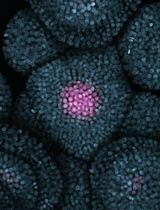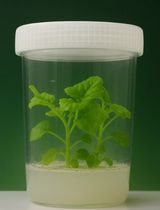- EN - English
- CN - 中文
Micrografting Technique of Hevea brasiliensis In Vitro Plantlets
橡胶树体外植物幼苗的微接技术
发布: 2025年02月20日第15卷第4期 DOI: 10.21769/BioProtoc.5215 浏览次数: 1076
评审: Samik BhattacharyaPreeti SinghAnonymous reviewer(s)
Abstract
To prepare Hevea brasiliensis plantations, selected planting material is propagated by grafting using illegitimate seedlings as rootstocks, whose paternal genotype is unknown. Recent advances in rubber tree in vitro cloning propagation open the possibility of using these techniques to supply new planting material. Micrografting is a promising technique to speed up the preparation of plant material for rootstock–scion interaction studies. This article describes the implementation of an efficient micrografting technique from Hevea in vitro plants from clone PB 260. The procedure combines several conditions to preserve the root system and the grafted scion and to prevent any breakage of rootstock buds. This technique paves the way for clonal propagation and holds potential for further development on other rubber clones for further studies on the interaction between rootstock and scion.
Key features
• This protocol requires rejuvenated in vitro plantlets.
• Requires between 40 and 60 days before scion bud break.
• Sterile working conditions.
Keywords: Budding (芽接)Background
Hevea brasiliensis is the main source of natural rubber, which is harvested by regular tapping of the trunk, and accounts for 42% of world rubber consumption. Like many perennial species, the rubber tree is an allogamous species that requires grafting to clone selected material. In contrast to fruit tree species in which the scion and the rootstock are the selected planting material, rubber tree propagation has been carried out by grafting, using scion clonal material and illegitimate seedlings as rootstocks, whose paternal genotypes are unknown. This planting material has resulted in heterogeneity in rubber plantations due to the non-clonal rootstock component. Microcutting and somatic embryogenesis have been introduced to overcome this heterogeneity problem [1,2]. The use of clonal rootstock material could be an alternative to improve the productivity of rubber plantations [3]. In fruit trees like chestnut [4], micrografting is also used to obtain disease-free material for early detection of scion/rootstock incompatibility. A first attempt at micrografting has been made in Hevea to rejuvenate clonal lines for micropropagation [5]. Perrin and collaborators micrografted rubber bud tips onto one-month-old sterile seedlings used as rootstocks. Microcutting lines were then established from this micrografted material. Because of the low multiplication rate and the time required for rejuvenation in the microcutting procedure, somatic embryogenesis emerged as an alternative. Over more than a decade, somatic embryogenesis has evolved into a short-term process using compact callus and a long-term propagation method using friable embryogenic callus lines [2,6]. The latter has been widely and successfully used for the implementation of genetic modifications [7–9] and functional characterization of genes of interest [10–12]. However, even though these techniques are robust and well-established, they are still restricted to some rubber clones. On the other hand, mastery of micrografting is still insufficient to support studies such as the analysis of rootstock/scion interactions using rejuvenated and clonal material. The aim of this research is to propose an efficient micrografting procedure in rubber using in vitro–rejuvenated plantlets from somatic embryogenesis.
Materials and reagents
Biological materials
Here, 2.5-months-old vitroplants were used, after germination of the somatic embryos, having reached between 1 and 2 leaf stages with root development equivalent in size to the one of the aerial part.
1. Hevea in vitro plantlets of interest for scion sampling. Plantlets should have the same diameter as the rootstock to make it easier to cut the scion
2. Hevea in vitro–rooted plantlets of interest to be grafted (serving as a rootstock)
Materials
1. Sterile round filter paper 85 mm diameter as culture support (Whatman, catalog number: 1001085)
Reagents
1. Agar agar (Sigma, catalog number: A1296)
2. NH4NO3 (Labover, catalog number: A0501-1000)
3. KNO3 (Sigma, catalog number: 1050611000)
4. NaH2PO4·H2O (Labover, catalog number: 13429448)
5. CaCl2·2H2O (Sigma, catalog number: 1420021000)
6. MgSO4·7H2O (Sigma, catalog number: 23039)
7. H3BO3 (Sigma, catalog number: B6768)
8. MnSO4·H2O (Sigma, catalog number: M7899)
9. ZnSO4·7H2O (Sigma, catalog number: Z0251)
10. CuSO4·5H2O (Sigma, catalog number: C8027)
11. NaMoO4·2H2O (Labover, catalog number: S0525-25)
12. KI (Sigma, catalog number: P8166)
13. CoCl2·6H2O (Sigma, catalog number: C8661)
14. Myo inositol (Sigma, catalog number: I7508)
15. Nicotinic acid (Labover, catalog number: N0611.0100)
16. Pyridoxin HCl (Labover, catalog number: P0612.0050)
17. Thiamin HCl (Labover, catalog number: T0614.0025)
18. D(+) Biotin (Labover, catalog number: B0603.1000)
19. Calcium pantothenate (Sigma, catalog number: C0400000)
20. Ascorbic acid (Labover, catalog number: A0602.0100)
21. Choline chloride (Sigma, catalog number: C1879)
22. Cysteine HCl (Labover, catalog number: C0706.0100)
23. Glycine (Labover, catalog number: G0709.1000)
24. Riboflavin (Labover, catalog number: R0613.0025)
25. FeSO4·7H2O (Sigma, catalog number: 1039630001)
26. Na2EDTA·2H2O (Sigma, catalog number: E6635)
27. Sucrose (Labover, catalog number: S0809.9025)
28. Osmosis water
Solutions
1. MACRO MS 10× stock solution (see Recipes)
2. MICRO MH 100× stock solution (see Recipes)
3. Vitamins 1,000× stock solution (see Recipes)
4. Fe-EDTA 100× stock solution (see Recipes)
5. Germination culture (GER) medium (see Recipes)
Recipes
For each stock solution, mix the components, in the order listed, with osmosis water. These stock solutions can be kept for one month in the refrigerator or for up to one year in the freezer at -20 °C.
1. MACRO MS 10× stock solution
| Reagent | Final concentration |
|---|---|
| NH4NO3 | 400 μM |
| KNO3 | 400 μM |
| NaH2PO4·H2O | 40 μM |
| CaCl2·2H2O | 30 μM |
| MgSO4·7H2O | 60 μM |
2. MICRO MH 100× stock solution
| Reagent | Final concentration |
|---|---|
| H3BO3 | 15,008 μM |
| MnSO4·H2O | 10,000 μM |
| ZnSO4·7H2O | 4,000 μM |
| CuSO4·5H2O | 148 μM |
| NaMoO4·2H2O | 99 μM |
| KI | 500 μM |
| CoCl2·6H2O | 101 μM |
3. Vitamins 1,000× stock solution
| Reagent | Final concentration |
|---|---|
| Myo inositol | 300 μM |
| Nicotinic acid | 20 μM |
| Pyridoxin HCl | 3 μM |
| Thiamin HCl | 2 μM |
| Biotin | 0.2 μM |
| Calcium pantothenate | 1 μM |
| Ascorbic acid | 1 μM |
| Choline chloride | 1 μM |
| Cysteine HCl | 60 μM |
| Glycine | 5 μM |
| Riboflavin | 1 μM |
4. Fe-EDTA 100× stock solution
| Reagent | Final concentration |
|---|---|
| FeSO4·7H2O | 10 μM |
| Na2EDTA·2H2O | 10 μM |
5. Germination culture (GER) medium
| Reagent | Final concentration |
|---|---|
| Macro MS 10× | 0.5× |
| Micro MH 100× | 1× |
| Fe-EDTA 100× | 1× |
| Vitamins 1,000× | 1× |
| Sucrose | 234 mM |
| Agar | 7 g/L |
Mix all medium components in osmosis water. Adjust pH to 5.8. Autoclave for 20 min at 120 °C. Dispense 5 mL of liquid medium into sterile tubes and the semi-solid medium in Petri dishes. Media can be stored for 1–2 weeks at room temperature in the dark.
Equipment
1. Laminar flow hood
2. Magnifying glass
3. Sterile fines clamp
4. Sterile large clamp (for plantlet manipulation)
5. Sterile scalpel
6. Sterile razor blade
7. Sterile blade holder
8. Food-grade plastic film
Software and datasets
1. XLSTAT software (for data analysis) (Addinsoft, version 2023.1.1., Lumivero [13])
Procedure
文章信息
稿件历史记录
提交日期: Sep 5, 2024
接收日期: Dec 23, 2024
在线发布日期: Feb 9, 2025
出版日期: Feb 20, 2025
版权信息
© 2025 The Author(s); This is an open access article under the CC BY-NC license (https://creativecommons.org/licenses/by-nc/4.0/).
如何引用
Dessailly, F., Montoro, P., Melliti, S. and Leclercq, J. (2025). Micrografting Technique of Hevea brasiliensis In Vitro Plantlets. Bio-protocol 15(4): e5215. DOI: 10.21769/BioProtoc.5215.
分类
植物科学 > 植物育种 > 微体繁殖
植物科学 > 植物发育生物学 > 综合
生物科学 > 生物技术 > 微生物技术
您对这篇实验方法有问题吗?
在此处发布您的问题,我们将邀请本文作者来回答。同时,我们会将您的问题发布到Bio-protocol Exchange,以便寻求社区成员的帮助。
提问指南
+ 问题描述
写下详细的问题描述,包括所有有助于他人回答您问题的信息(例如实验过程、条件和相关图像等)。
Share
Bluesky
X
Copy link











